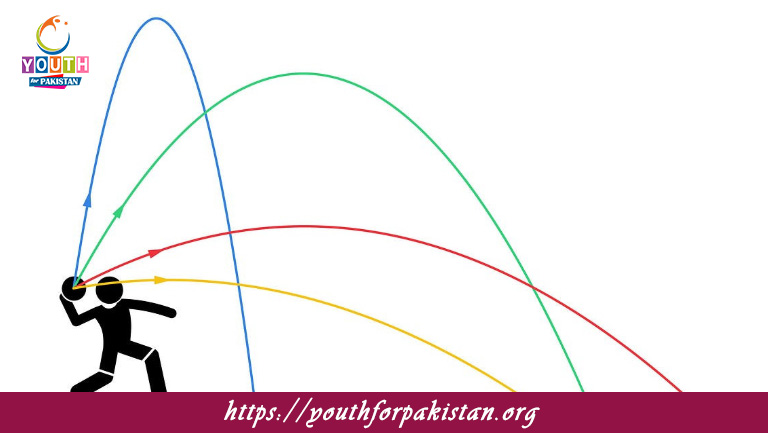Projectile Motion MDCAT MCQs with Answers

Welcome to the Projectile Motion MDCAT MCQs with Answers. In this post, we have shared Projectile Motion Multiple Choice Questions and Answers for PMC MDCAT 2024. Each question in MDCAT Physics offers a chance to enhance your knowledge regarding Projectile Motion MCQs in this MDCAT Online Test.
Projectile Motion MDCAT MCQs Test Preparations
What is the shape of the trajectory of a projectile?
a) Straight line
b) Parabola
c) Circle
d) Ellipse
The horizontal component of the velocity of a projectile remains:
a) Zero
b) Constant
c) Increasing
d) Decreasing
The range of a projectile is maximum when the angle of projection is:
a) 30°
b) 45°
c) 60°
d) 90°
If a projectile is launched with an initial velocity of 20 m/s at an angle of 30°, what is the horizontal component of the velocity?
a) 10 m/s
b) 17.32 m/s
c) 15 m/s
d) 20 m/s
The vertical component of the velocity of a projectile at the highest point of its trajectory is:
a) Zero
b) Equal to the horizontal component
c) Maximum
d) The same as the initial vertical component
For a given initial velocity, increasing the angle of projection from 30° to 60° will:
a) Increase the range
b) Decrease the range
c) Not affect the range
d) Increase the time of flight
The time of flight of a projectile is independent of:
a) The initial velocity
b) The angle of projection
c) The horizontal range
d) The acceleration due to gravity
The horizontal distance covered by a projectile before it hits the ground is called:
a) Maximum height
b) Time of flight
c) Horizontal range
d) Vertical displacement
The angle of projection for a projectile to achieve maximum range is:
a) 30°
b) 45°
c) 60°
d) 90°
A projectile is launched with an initial velocity of 30 m/s at an angle of 45°. What is the time of flight?
a) 6 s
b) 3 s
c) 4 s
d) 5 s
The vertical motion of a projectile is similar to:
a) Uniform circular motion
b) Uniform motion
c) Free fall
d) Simple harmonic motion
At the maximum height of its trajectory, the kinetic energy of a projectile is:
a) Maximum
b) Zero
c) Equal to its potential energy
d) Half of the total energy
The vertical component of the velocity of a projectile just before hitting the ground is:
a) The same as it was at launch
b) Zero
c) Equal to the horizontal component
d) Half of the initial vertical component
The trajectory of a projectile is symmetrical with respect to:
a) Maximum height
b) The horizontal distance
c) The point of launch
d) The time of flight
The time to reach the maximum height of a projectile is equal to:
a) The total time of flight divided by 2
b) The maximum height divided by the initial velocity
c) The horizontal range divided by the horizontal component of velocity
d) The vertical component of velocity divided by gravity
The angle of projection for a given range is always:
a) 45°
b) Less than 45°
c) More than 45°
d) Either 45° or complementary to 45°
The horizontal distance covered by a projectile when it returns to the same level from which it was projected is called:
a) Maximum height
b) Range
c) Time of flight
d) Vertical displacement
The horizontal motion of a projectile is:
a) Accelerated motion
b) Uniform motion
c) Variable motion
d) Non-uniform motion
The trajectory of a projectile is a parabola because:
a) The horizontal velocity is constant
b) The vertical velocity is constant
c) The acceleration is constant
d) The vertical acceleration is constant
When a projectile is launched at an angle
θ, the horizontal range is independent of:
a) The launch velocity
b) The launch angle
c) The acceleration due to gravity
d) The height from which it is launched
If the angle of projection is 90°, the projectile motion becomes:
a) Horizontal motion
b) Free fall
c) Uniform motion
d) Uniform circular motion
For a projectile, the total mechanical energy is:
a) Only potential energy
b) Only kinetic energy
c) The sum of kinetic and potential energy
d) Constant
At the maximum height, the projectile’s potential energy is:
a) Zero
b) Maximum
c) Half of the total energy
d) Equal to the kinetic energy
The distance traveled by a projectile in the horizontal direction is equal to:
a) The horizontal component of velocity multiplied by time of flight
b) The vertical component of velocity multiplied by time of flight
c) The initial velocity multiplied by the vertical component
d) The initial velocity multiplied by the horizontal range
For a projectile launched at an angle of 45°, the horizontal range is:
a) Maximum
b) Minimum
c) The same as for any other angle
d) Twice the height
The time of flight of a projectile depends on:
a) The angle of projection
b) The horizontal component of velocity
c) The vertical component of velocity
d) The initial velocity and angle of projection
The height of a projectile can be calculated by:
a) Using the vertical component of the velocity
b) Using the horizontal range
c) Multiplying the initial velocity by time of flight
d) Subtracting the horizontal range from the maximum height
If the projectile is launched with the same speed but at different angles, the maximum height achieved will be:
a) The same for all angles
b) Maximum for a 45° angle
c) Maximum for a 90° angle
d) Minimum for a 90° angle
The horizontal distance covered by a projectile in the time of flight is its:
a) Maximum height
b) Vertical displacement
c) Range
d) Time of flight
A projectile with a higher launch speed will have:
a) A lower maximum height
b) A smaller range
c) A longer time of flight
d) A shorter time of flight
If you are interested to enhance your knowledge regarding Physics, Chemistry, Computer, and Biology please click on the link of each category, you will be redirected to dedicated website for each category.





